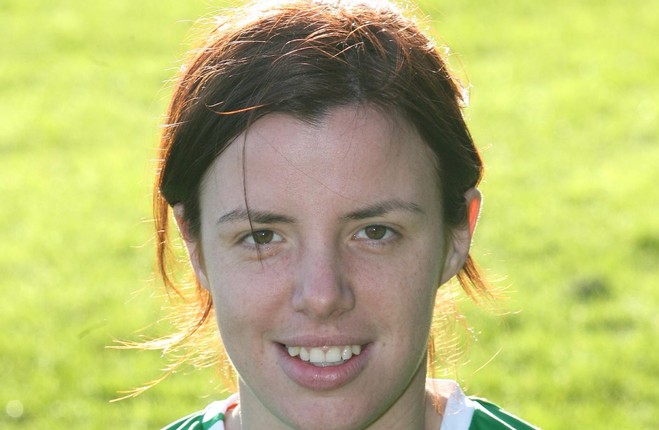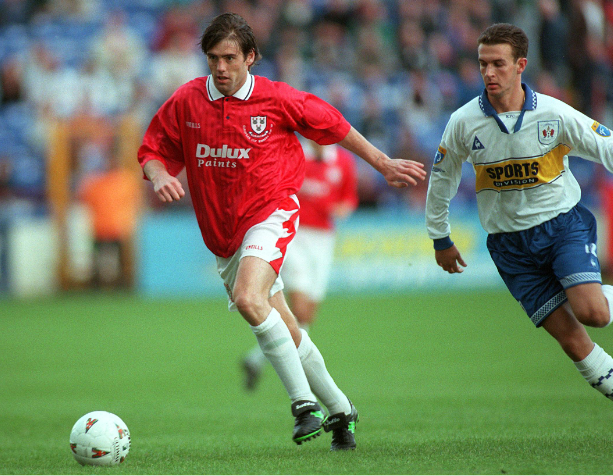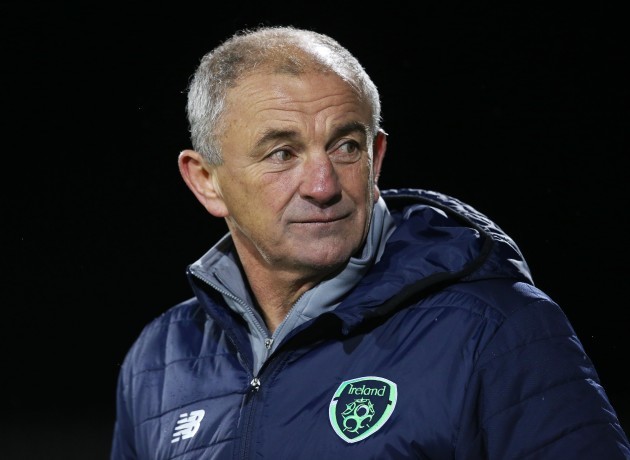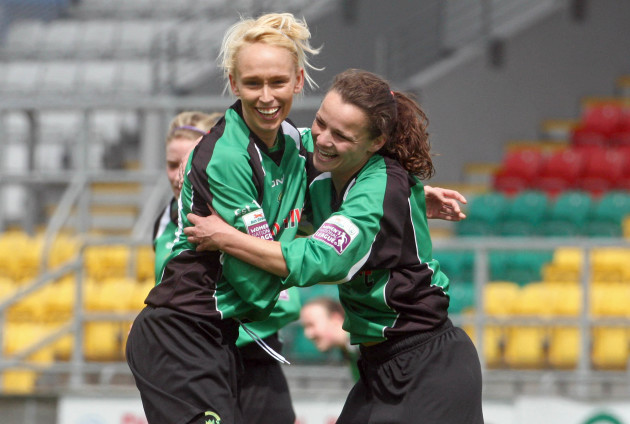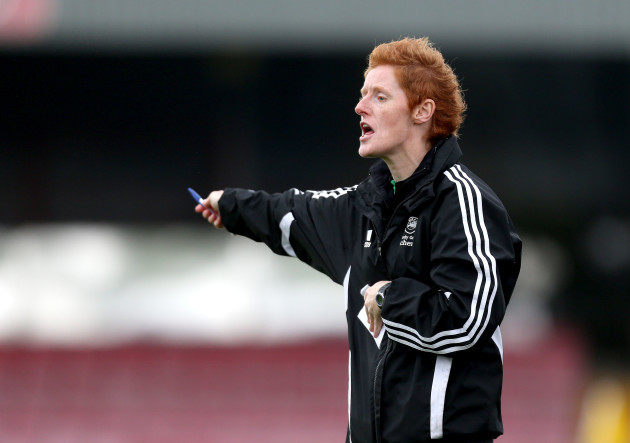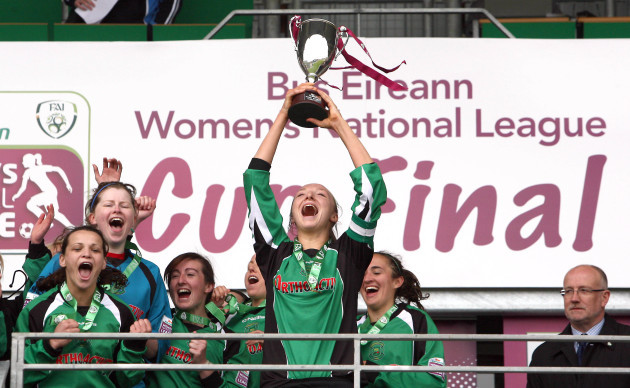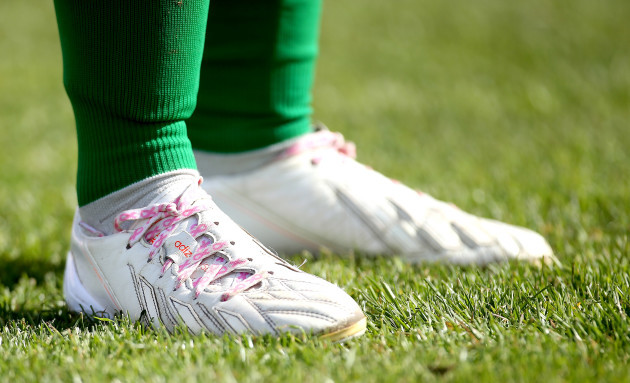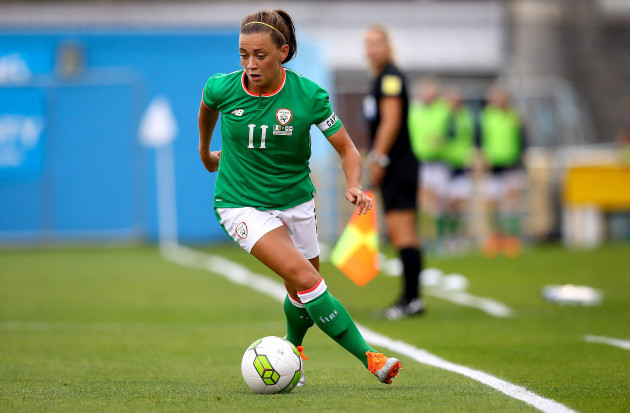SUSAN BYRNE WAS never one to just go with the flow.
Around the age of eight, she started playing for Bohemians’ boys side. There were no female teams available to her at the time. She was, she believes, “one of the first” girls to play in the Dublin and District Schoolboys League.
At a certain age though, girls are no longer permitted to play in boys’ leagues. Byrne and her father, along with the club, advocated for this rule to be changed, and ultimately, she was allowed to stick around for another year, before being required to leave at 13.
Still, the high standard of boys’ football stood to her. Tony Sheridan, the father of the renowned ex-Shelbourne player of the same name, was setting up a girls team at Lourdes Celtic. He proceeded to recruit some of the best female players from around the country.
“We won everything domestically,” Byrne tells The42. “U12s, U16 leagues, cups, All-Irelands. Basically, that team was assembled from girls who all had played on boys teams, so we had an advantage starting up that league.
“Tony Sheridan would be up there with Brother Bernard in terms of what he did for women’s football. He took a chance, brought us all together. We ended up going out on an international tournament to Minnesota when we were with Lourdes, which I don’t even think we got permission for from the Football Association of Ireland.
Tony had arranged it. It was just completely organised by volunteers, this international tournament. It was only when we got there we realised we should have sought permission from the FAI. That was Tony for you. We had great experiences out there as well.
“But when I was at Lourdes Celtic, there wasn’t much after U16s. There wasn’t a progression. There was U16s and then senior.”
Byrne started attracting interest from elsewhere during her spell at Lourdes, and soon began appearing in Dublin, Leinster and Ireland underage squads.
Thereafter, she linked up with current Ireland assistant boss Eileen Gleeson, who was coaching St James’ Gate, joining some of the best young players in the country on the team.
Byrne’s performances gained attention Stateside. At 18, just after finishing her Leaving Cert, she agreed to take up a scholarship in the New York-based St John’s University.
“It was the hardest transition for me,” she recalls. “I was homesick for a year and a half.
“I had all the support in the world at St John’s when I think of some of the [Irish] girls going out now to clubs in Germany and Scandinavia. I know they’re full-time athletes, but you kind of wonder what support they have inside that. I had an academic adviser. I had after-school study. I had access to a sports psychologist. I had a strength-and-conditioning coach. I had a team and college mates around me.
“I studied criminal justice. It’s not worth a curse back here. It doesn’t transfer over very well. It would have been American law, so it wouldn’t have been overly relevant here.
“I did enjoy it. But I never said I went to America to go to college, it was always ‘to play football’. So that was four years and I stayed an extra year. But it’s such a short season. You could be playing Friday at home and then flying or driving down the country to Florida or Austin or wherever on a Sunday and then flying back. So it’s tough. It’s a very professional set-up. I wouldn’t say it’s easy. But at least I did have support out there.
“The biggest weakness of my game was always athleticism. I’m not very athletic — I never was, I never will be. I’m pretty sure I’m allergic to exercise. I definitely felt I could compete tactically and technically.
“Obviously, [Americans tend to] do three or four sports in school. They’re phenomenal athletes. But I think, after three or four months, I was able to adapt my game and bring the strengths I had.
Aside from the athleticism, I felt like I was on a par — I didn’t feel out of place in college. I won Player of the Year and Players’ Player of the Year while I was in college as well, so I didn’t feel like I struggled.
“During that time, I did 16s, 19s and then was in the [Ireland] senior squad, primarily under Noel King — he was the senior guy at the time. I don’t think they particularly liked flying people home from America at that time. It was an extra cost. So there was always a bit of resistance, but I was flown back to be fair.
“Then I think a turning point for me was the World Student Games. That’s obviously not a recognised Uefa competition. Any other international game or camp, it’s in your contract that you’re released for it.
“So I was selected for the World Student Games and I couldn’t go — I wasn’t allowed to go by the university, which was a bad mistake on their part. The only way I get fit is through playing matches. So it was either do pre-season in America, where it’s the usual slog of fitness work. I get better with match fitness. Playing six games in 10 days would have suited me better than doing pre-season. I tried to say that to the coaches. I wasn’t allowed go. That upset Noel at the time. He felt that I should have [gone].
“There was me and Marie Curtin, who went to Hofstra University. She got the same ultimatum from her college — either you stay and do pre-season, or you go and don’t come back. She called their bluff and went, and they cut her scholarship. They ended up taking her back a year later I think, but I kind of knew they would have done the same to me. So I had to stay out there.”
And did King sympathise with her predicament?
“He was unhappy [about it]. Noel likes people saying ‘yes’ to him. I had a good relationship with Noel, but it was just one of those things that I had no control over. I felt like it was a mark against me for not going out.
“To be honest, I never particularly enjoyed being with the senior squads. Obviously, it was great to represent Ireland. In terms of being in camp [not so much].
“You’ve obviously seen stories coming out about the strike. But at the time, you don’t know any different. The goal is to represent your country. You don’t know what the standard is. You just go in. I didn’t have anything to compare it to. You just assume that was the way it was.
“There was a camp in Indiana. I think it was one of the first of its time. It was five weeks.
“I was in America at the time. I was nearly finished. I think the only reason I was invited was because I was an American-based player.
And you couldn’t make it up. The apartments we were put in were completely unfurnished. I had arrived late. The girls who were there had had to buy sheets for duvets and beds. I remember walking into the apartment I was staying in, a few of the girls were in it. There were deck chairs instead of actual tables and chairs. The beds were like something from Alcatraz.
“Nearly everyone who came back gained weight. We laugh about it now and call it the fat camp.
“I ended up picking up an injury. There wasn’t even a physiotherapist out on the trip. I picked up a quad injury and a back injury and it was a local chiropractor I was sent to. There wasn’t even a physio brought out onto the trip. And nobody talks about that. That was, I think, 2008 or 2009.
“They’ll look back on that strike [undertaken by the women's national team in 2017] in years to come and they’ll realise how important it was to do it. I know a number of them were threatened with their international careers if they went on strike. But they all stuck together — unity in numbers.
“I know a lot of players individually would have liked to stand up to them over the years. They were fearful that if they did it, they’d be ostracised from the squad. I was delighted when they did it, and linked up with the PFAI [Professional Footballers' Association of Ireland]. I’m still friends with a lot of the players in the squad at the moment, and they can’t believe they were even dealing with it. You’re just there to play football, they shouldn’t be in on the terms and conditions and the politics, what you are or aren’t getting paid, are you compensated for getting off work or not.
“It’s not something players should be dealing with and I definitely think it takes away from what they’re supposed to be concentrating on. So it’s small steps in the right direction — there’s still a long way to go.”
And was a group strike ever considered during Byrne’s time with the Ireland squad?
“Never. I think sometimes it’s an Irish mentality as well: ‘Ah, we’ll be grand.’ You’re representing your country. It’s huge when you tell people you’re representing Ireland. They’re like: ‘Oh, that’s amazing.’ Then you’re like: ‘Oh, it’s alright.’”
After five years studying and playing in the US, Byrne returned to Ireland.
“I came home and I wasn’t sure what I really wanted to do. I was burnt out a small bit from being in America. It was very intense.”
In 2010, she once again linked up with Gleeson, who was now coaching Peamount. The team would win numerous accolades. They did the domestic treble in Byrne’s first season. She was also named Players’ Player of the Year in both 2010 and 2011. The highlight, though, was probably the team’s Champions League appearances in the 2011-12 and 2012-13 campaigns. In the process, they became the first Irish team, male or female, to reach the competition’s knockout stages.
“It definitely went from a community side to a competitive side, I thought. Obviously, Eileen dragged the standards up. The first few years were a great success there.
The first year and even the second year with Eileen, training was harder than anything that was happening in the league. I’d be going training and I’d be up against Sara Lawlor and Steph Roche. Dora O’Gorman, Ruth Comerford, Katie Taylor, Louise Quinn — the who’s who of women’s football at the time.
“A lot of the players I came up with through St James’ Gate and Lourdes Celtic as well. We all knew our strengths and weaknesses. And we had the Hollywood players. There’s still not a striker like Sara Lawlor in the league [now].
“Training was definitely more competitive than [league] matches. We had all the coaching that first and second season. Then obviously, we had the Champions League spells. The first one we were allowed to invite guest players, so we had [Ireland international] Denise O’Sullivan in. For that first squad that went to the Champions League, I don’t think there was another Irish player in the country that you would have wanted on your team.”
Around this period, a number of Peamount’s players were getting Ireland call-ups, however Byrne was frequently overlooked at international level. She suggests it may have been due to a previous incident when she was a younger player.
“I definitely wasn’t someone who toed the line and would say ‘yes, yes, yes,’” she explains.
“We were playing the Olympic champions, during their tour. In Philadelphia, New York and Chicago, we had matches with the American team. I was American-based at the time.
“I was out of season, so I didn’t feel particularly like I should be starting anyway. I didn’t get any time in the first or second game. In the third game, we played in Giants Stadium in New York. I was living in New York at the time. I had loads of friends and team-mates coming to the match. I think Noel was trying to give me a token cap in the 88th minute or something like that. We were 2-0 down. He asked me to go on and I said ‘no’. I kind of knew the writing was on the wall then.
I was a centre-half. We were 2-0 down against the Olympic champions with two minutes to go. I’d only want to play for Ireland if I was making a difference or actually adding something to the team. I’m not just going to go in and collect a cap. After that, Noel said: ‘A lot of people would give their left arm to play for Ireland’ and I had refused to do it.
“But a few years later, I was sitting at a charity dinner. I was sitting beside [former Ireland internationals] Ray Houghton and Packie Bonner. I was relaying the story to Ray and he said I was right and a few other choice words, but I felt very validated when I had the likes of Ray Houghton and Packie Bonner saying I was right.
“Maybe it’s horses for courses and I just didn’t fit into the plan, but I definitely felt that at the time when I was playing well, I could have been in it. But I don’t know [for sure] the reason I wasn’t selected, you’d probably have to ask them.”
Byrne finished her career with nine international caps at senior level, though she undoubtedly feels it could have been more, having represented Ireland U19s as early as the age of 15.
The Dubliner also stepped away from club football around the time that Peamount side was breaking up. Gleeson and a number of players left to join UCD Waves following a disagreement with the club’s hierarchy. Louise Quinn moved to Swedish outfit Eskilstuna United, while Stephanie Roche was gaining significant fame on the back of her extraordinary Puskas Award-nominated goal, subsequently earning a move to French team ASPTT Albi.
“I stepped back for personal reasons at that time when Eileen was going into UCD,” Byrne recalls. “I just didn’t have the passion to continue on with it.
“The team was going in separate directions anyways. My second last season with Peamount, my mam got sick, so I was missing training and missing games. Then my mam passed away [Byrne initiated a high-profile breast cancer awareness campaign in women's soccer following her mother's passing].
“I couldn’t get back. I remember the first match the year I came back, I just kept thinking to myself: ‘I can’t wait till this is over.’ I was only on the pitch about 10 minutes, I was like: ‘Get me out of here.’
“You go through spells where you’re not motivated, but then I was like: ‘I actually don’t care which way this game goes.’ I’d lost the passion for it. Particularly in sport, if you want to get to a really high level, you have to be obsessed. Growing up, I was definitely obsessed. Playing with Lourdes Celtic and even up until that second year with Peamount, it was an obsession. But as you’re getting older, you have to think about your career.
There’s no money in it yet. We’re still waiting for the big superstar of women’s football. I know in the French league they’re starting to pay really well and America obviously, but I don’t think we’ve had a superstar. The potential is there with Denise [O'Sullivan], Katie McCabe if she keeps training the way she’s training and playing the way she’s playing, she could get that superstar status and wages. But they definitely weren’t there when I was playing, so you had to say to yourself: ‘I’ve given so much time to this and for what? Is it worth it?’
“When I was playing, I never really had a stable job. I was in and out of jobs. I wasn’t committed. It was only since I stepped away that I was able to get a job and settle in a job properly and not be sidetracked. The National League, it was great the first year, but you could be training twice or three times a week. You were travelling at the weekends down the country. And if you’re working 9-5, or sometimes I was working shift work, you didn’t know which end was up. It was just too much.
“Even now, there are not that many competitive games in the Women’s National League. You might have three games a season where you’re like: ‘Right, this is going to be a tough one.’ Yet you’re still putting in those hours.
“The funding’s not there. I remember when Peamount had to do their application just to get into the league, there was a criteria — you had to have facilities, player development, a strategy. There were so many boxes that had to be ticked. And I remember when the club heard that they got league status, there was a celebration, it meant so much and it was this big thing.
“The criteria is very loose for registering teams now. There were games where referees didn’t turn up, but it actually wasn’t the referee’s fault. The FAI hadn’t booked the referee. I know the referees got the blame that time, but the communication was just off.”
Now 33, Byrne has no regrets about her decision to step away from football in her late 20s, while somewhat disillusioned by the lack of funding and promotion afforded to the women’s game, among other issues.
She has considered coaching since then, undertaking courses with this possibility in mind.
“Eileen was trying to encourage me to get into it. But it’s just a different craft, coaching. I don’t think ex-players appreciate that it is a different craft. Just because you’re a good player doesn’t mean you’re going to be a good coach. It’s definitely an education that you have to pursue.
“I did that FAI Youth Cert. I actually remember asking one of the tutors: ‘How long has what they’ve been doing on this course been implemented?’ He said: ‘Probably 10 or 12 years.’ I said: ‘Who have we produced in the last 10 or 12 years?’ And this is what you’re teaching coaches? I don’t even think I finished it.
“There were one or two that I thought were decent coaches on it. I remember asking for feedback. I won’t name names. He said: ‘Well, I saw how you played the game and I just expected a little bit more.’ I was just like: ‘That’s completely irrelevant.’
“Another coach I asked for feedback and he was like: ‘Ah well, you know yourself.’ I was like: ‘Actually, I don’t.’ I was very disillusioned with it.
“But I think, to be a coach, you just have to go out, get off the ground, take a team, and do all the graft, as opposed to going in and picking up a token B badge.”
For all her disillusionment with aspects of the game, Byrne began to rediscover her love for football more recently.
I went back a few years ago to play a summer season with an inner-city club. It was the first time in a long time that I actually enjoyed being part of a team.
“It was the first team I saw that regardless of the calibre of player in the dressing room, every single one of them had a voice. It was just the freedom to go out and play.
“Everyone had a positive word to say. It was just such a laugh. Sara Lawlor came back for that as well. We ended up winning an intermediate All-Ireland.
“I don’t remember it particularly for the standard. It was what I remembered when I enjoyed football. What it was like not worrying about the politics, just going out and playing a football match.
“And that was it. Then Louise and Katie McCabe asked me to do that charity game a couple of weeks ago in the Aviva. I went under duress and again, it was great to see everyone, I loved the social aspect of it. But people were like: ‘Oh my God, you’re in the Aviva,’ I was like: ‘Meh.’ I didn’t get that bite back for it that I thought I would have.”
And while she never secured a big move abroad, nor did she ever receive the level of attention and scrutiny that the Ireland internationals of today receive, Byrne remains extremely grateful for all the game has given her.
“I’m working for a housing charity now. I’m really enjoying it. I think the fact that I played in teams has really stood to me. I’m in a team now, even though professionally it’s a job. We have goals that we all have to reach and help each other reach together. So I definitely think it’s shaped me. It’s given me so much. I’ve travelled the world. I’ve met some of my closest friends. I’ve had some great experiences and got to meet some amazing people as well. So it’s been a great door opener for me.
“But in terms of adapting away from it, I thought I’d miss it more. I’m always on social media. Any success we have, I’m hands up the biggest bandwagoner ever. If someone’s doing well in a particular event, I’m looking for tickets. I’ll always be a supporter of the game. If anyone ever needed anything, I’d do it for them.
I have a lot of friends in football, even on the senior team that I’d be chatting to. But the game is growing. You kind of have to remind them: ‘What are you going to do after?’ I’m 33 now and I’m only starting out in a career, whereas maybe you would [otherwise] be doing that 10 years ago, getting into a field that you like and progressing. So it’s just about keeping one eye on the future, what’s going to happen after.
“Some people ask: ‘Do you wish you were playing now [instead of] 10 years ago?’ I say ‘no’.
“I definitely was happy with what I had. A lot of people will probably say that I didn’t fulfil my potential, but as you get older, you realise there is more to football.”
The42 is on Instagram! Tap the button below on your phone to follow us!
